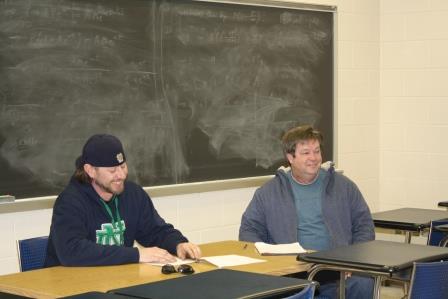
DUBOIS – A small business owner with three decades of experience in his field visited Penn State DuBois business students recently to impart some real-world lessons on what it takes to successfully operate a business.
John McCreary is the owner and operator of Rustic Barns, based in Hollidaysburg. He specializes in building custom sheds and other outbuildings, providing a high-quality alternative to prefabricated sheds and buildings. He has owned the business since 1985.
McCreary was interviewed by business major Christopher Brennan as part of an assignment for the Business 250 class, Problems of Small Business, which requires each student to invite a small business owner to campus and interview that that person about their experiences in front of the class.
“Each student in my class was given the task of interviewing a local small business owner who could choose to come to campus to share his or her story with the entire class. Students benefit by hearing first-hand accounts of real business life that they will remember long after they have forgotten what they read in a book,” said Senior Instructor in Business Administration Annette Muth.
Having personal experience working for, and with McCreary, Brennan said he made an educated choice when deciding who to interview for the assignment. He said, “John and I have worked together for 10 years, off and on, and he has taught me so much about business. I knew he would be an excellent person to interview and would be really helpful to the other students.”
During the interview, McCreary provided students with a range of advice including not just things to do, but also practices to avoid, to help one find success as a small business owner. He told the class he started out very early learning how not to run a business.
“I started working right out of high school at a company building sheds. They did it cheaply and poorly. I learned how not to do it,” McCreary said. “When you have a business, your name is on everything you do.”
He moved on to a competing company that had a reputation for higher quality, and quickly learned, from the company’s owner, to execute his work with pride.
During a downturn in the market for that industry in 1985, that owner decided to sell, and McCreary bought the company where he learned his craft. Since then, he said he has constantly learned new lessons, both good and bad. The most important of which is to always provide the best experience for the customer.
“Customer service is so important,” McCreary said. “I take no deposits. They’re allowed to pay me when they’re satisfied. People appreciate that.”
But his path did not come without pitfalls, which he also looks to now as lessons learned. He acknowledged that he once expanded his company past the point where he was able to sustain it, branching out too far by building a large commercial facility and spreading into new areas of the construction industry.
“I was very naive when I built my commercial building,” McCreary confessed. “I had a lot of money wrapped up in it, too much invested, and I couldn’t win. It was a downward spiral.”
But McCreary learned valuable lessons from that hardship, and turned things around. He is now able to counsel students using that experience.
He said, “I sold my building and scaled the business back when it got to be too much. Not extending myself out too much, and working with cash to not drive myself into debt has worked a lot better for me.”
Bringing his business back to its core mission, McCreary said, ultimately helped it to flourish again, which was a final point he was happing to outline for the class. He said, “Stay true to your vision. Visualize your path and stay on it. The next best thing could be right around the corner.”